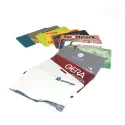2023-04-28
Difference Between Contact IC cards and Contactless cards
IC cards are divided into contact cards and contactless cards, both of which belong to the RFID category. The chip of the contact IC card is directly packaged on the surface of the card base, while the non-contact IC card is composed of a chip and a coil, which can be divided into COB copper wire, etched antenna, printed antenna, etc. The difference between the two applications is that the former needs to be inserted into the card reader during use, such as a bank card, and the latter can be read only by being close to the card reader induction antenna, such as a traffic card, or access control card.
RFID cards refer to non-contact electronic cards/labels, including ID cards, IC cards, NFC cards, and other electronic cards/labels. The main difference between them is the working frequency band.
The ID card is an early non-contact electronic tag. It has only one ID number in the working frequency band of 125kHz and cannot store any data, so it is called an ID card.
IC card, as understood from the meaning of the word, includes other RFID electronic tags and contact chip cards except for ID cards, but generally speaking, IC cards mainly refer to non-contact smart cards and contact smart cards that work in the 13.56MHz frequency band. Non-contact smart cards also include NFC cards or tags (NFC Forum stipulates that four card types belong to NFC cards) and contact smart cards are smart cards with a bare chip.
RFID cards also include electronic cards/tags in other working frequency bands, such as 915MHz, 2.4GHz, and others frequency bands.
Difference between NFC cards and RFID cards
NFC is developed based on RFID, and NFC is not much different from RFID in essence, both are based on the signal transmission between two geographically similar objects.
However, there are differences between NFC and RFID. NFC technology adds a point-to-point communication function, which can quickly establish P2P (point-to-point) wireless communication between Bluetooth devices. NFC devices discover and establish communication connections with each other. Two devices in P2P communication are peers, while two devices in RFID communication are in a master-slave relationship.
There are also some other technical details:
Compared with RFID technology, NFC has the characteristics of Short distance, High bandwidth, and Low energy consumption.
Details:
- NFC is only limited to the 13.56MHz frequency band! The frequency bands of RFID include low frequency (125KHz ~ 135KHz), high frequency (13.56MHz), and ultra-high frequency (860MHz ~ 960MHz).
- Working effective distance: NFC (Less than 10cm, High security), RFID distance from several meters to tens of meters!
- Because it also works at 13.56MHz, NFC is compatible with the existing contactless smart card technology, so many manufacturers and related groups support NFC, while there are many RFID standards, and the unification is more complicated (it is estimated that it is impossible to unify), only in special industries The corresponding technical standards can only be adopted under the special requirements of the company!
- Application: RFID is more widely used in production, logistics, tracking, asset management, etc., while NFC plays a huge role in access control, public transportation, mobile payment, and other fields.
XinyeRFID is a profession manufacture rfid cards factory engaging in RFID industry more than 15 years experiance. We provide various rfid smart card such as contact ic card ,contactless ic card,NFC cards and magnetic stripe cards.The product craft includes but is not limited to QR code , gloss/matte surface,UID number printing,lase number printing,embossing number.Please feel free to contact us and ask for some sample to test.
Categories
Title with button
this is a new beginning
We provide all your needed for starting your own online business, and even easier. Establish an online store, Oceans of Products Supply, Integrate Logistics Solution & Comprehensive After-sale Services.




